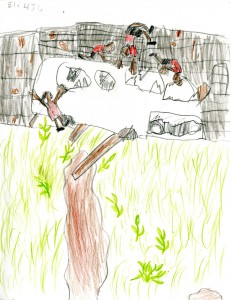

In these next photos, children are driving cars. Either they are playing on cars that were bought or found, or they use their imagination. These children are very creative. - Anele Bokuva
We’ve all heard the adage “every picture tells a story”. Every story has details and characters that flesh out the plot. Every viewer brings to the image their personal interpretation of the narrative based on what they may or may not already know about the subject. Like the book cover that catches our eye, can we assume to know the story without reading the pages?
Fourth, fifth and sixth grade students visiting the Apha exhibition this week spent time considering how the objects within the photographs help us to interpret the story being presented. We looked at Nwabisa Nake’s photograph with all labels and captions for the section covered. When stripped down to basic terms, such as labeling, we are forced to purge any preconceived ideas about what may be going on in the picture. Responding to the prompt “What do you see? What do you notice?” without replying with a storyline, the students struggled to answer the questions. They offered fully articulated, wonderfully imaginative tales at first. Slowly they reigned in their expressive language and learned to train their minds to read the photograph for the visual clues layered throughout. We started from the ground up, as though building a storyboard, until we had all of our pieces spread out on the table. The students were then asked to provide a story based on the information they collected. The results included wedding, performance (comedian, karaoke), birthday and christening (girl’s) scenarios. All students assumed the photograph represented a special occasion (clothing, decoration) and were surprised to learn that it displayed a weekly church service. The students were even more shocked to learn that the pink ribbons did not signify a celebration of the feminine, but rather that pink is a universal color. And further still, the teen boys consider it macho! We examined the role of bringing our prior knowledge with us into the viewing space. While worthwhile, it is not absolute. We can learn a lot about cultural standards by opening our eyes.
The science of photography allows for a portion in an evolving story to be captured in less than a second. The viewer knows nothing about what happened prior to or after the photograph was taken. The students were asked to select an image and create a story that happened before or after that moment in time. Fourth and fifth grade visual arts children set to task with paper and pencil while Katharine Hill’s sixth graders hammered out storylines on their computers. The results are thrilling and entertaining. Please visit them here.

I bookmarked this guestbook. Thank you for rattling well position! .